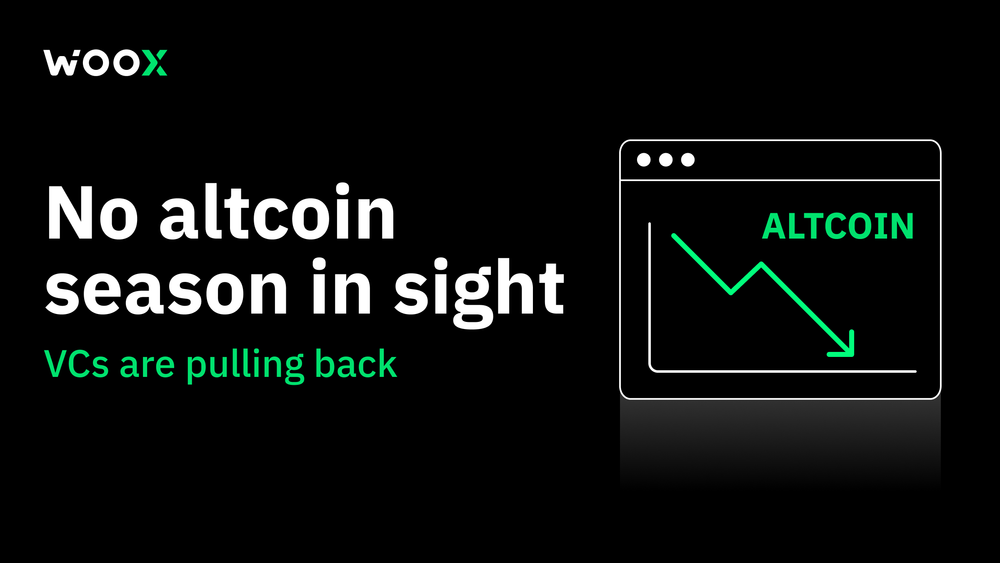No altcoin season in sight as VCs pull back
Bitcoin stands strong alone, while overall market sentiment remains weak
The overall risk market has recently been impacted by Donald Trump's trade war, with the S&P 500 index (SPX) dropping over 20% from its peak, and the tech index (QQQ) falling more than 25%, creating strong risk-off sentiment.
At the outset of the trade war, Bitcoin mirrored the decline of the US stock market, falling to $74,500. However, as the trade war persisted, Bitcoin diverged from US stocks and subsequently recovered, showing an 11% gain. Looking at the crypto market, historically, when Bitcoin rises, altcoin market caps follow suit. However, the situation has been different recently.
Data from BTC.D (approx. 64.4%, a 4-year high) and Total 3 (down approx. 22% since 2025) show that Bitcoin is currently dominating the crypto market.
What is the current state of the crypto market? Why has Bitcoin decoupled from US stocks? And where is Bitcoin's price ceiling? Read through WOO X Research.
Ref:TradingView
Narrative vacuum, VC exodus
The drought of crypto narratives is not new, particularly in the second half of 2024. The rise of pump-and-dump schemes and memecoins signals market rejection of "VC-backed altcoins." Players prefer tokens issued natively on chains rather than buying heavily funded tokens with inflated valuations on exchanges. Without major paradigm shifts or innovation, occasional hotspots fail to scale user growth and revenue. Although top-tier VCs hold early, cheap altcoin tokens, liquidity is hard to exit in a market that isn’t buying, making it difficult for VCs to reinvest in new projects and further tightening the already struggling altcoin market, creating a vicious cycle.
Behind the capital retreat is the shift of large institutions towards high-growth sectors like AI. A16z recently launched a $20 billion AI Megafund, setting a new fundraising record and marking a significant tilt in the "capital balance."
According to a Pitchbook report, 57.9% of global VC funding in Q1 flowed into AI and machine learning startups, more than double the 28% in the same period of 2024. AI startups raised $73 billion in Q1, surpassing half of the total AI transaction value for 2024.
Meanwhile, crypto and blockchain startups lag significantly, attracting only $4.8 billion in VC funding, nearly half of which came from Abu Dhabi-based MGX's $2 billion investment in Binance.
VCs are more interested in AI than in cryptocurrencies.
Top-tier crypto funds admitted in December 2024 that their investment focus for 2025 would shift to "projects with clear business models and real users," with most early-stage token projects being shelved or downsized.
ABC Capital, a leading Chinese VC with $400 million in assets, recently announced an immediate halt on new project investments and a suspension of second-phase fundraising. Co-founder Du Jun cited the current early-stage market's "short-sightedness and excessive pursuit of hype," conflicting with their long-term values.
This announcement quickly spread across Chinese and international media, confirming that while LPs are not pulling out, no new capital is entering. This marks the end of the "early-stage token booster" era.
DeFi also faces difficulties.
CoinGecko reports a $48 billion drop in Q1 2025's TVL, nearly erasing all gains from the second half of 2024. Kaiko’s report highlights that Q1's market spot trading volume fell back to pre-election levels due to the Trump tariff impact, indicating that buyers are on the sidelines.
No new funding for projects → Inability to build narratives → Investor confidence drops → More capital exits. The dual disconnection of funds and narratives has led to a 22% decline in Total3 since the start of the year, the worst performance in four years, while BTC.D stands at 64%, illustrating the "altcoin winter" reality. Without a new killer app or favorable policies, altcoins will likely continue to languish in a liquidity desert, delaying the start of the next cycle.
When will altcoin season arrive? Looking back at 2019-2021 patterns
Reviewing Bitcoin's performance in 2019, we observe the following stages:
- Synchronized uptrend: BTC price and BTC.D both rise together.
- Peak formation: BTC price continues to set new highs, but BTC.D peaks and stabilizes around 70%.
- Divergence: BTC enters consolidation, BTC.D falls sharply, and capital flows into altcoins (Altcoin season).
Compared to current data:
- Bitcoin price: After breaking previous highs, it remains in an accelerating phase (around $88k).
- BTC.D: Around 64% and still rising, not yet reaching past highs (≈70 %+).
Based on these patterns, market dominance is still in a synchronized uptrend phase, similar to mid-2019 to mid-2020. This suggests no clear signs of funds shifting from BTC to other assets yet.
If we later observe:
- BTC.D nearing or surpassing 68-70% but failing to make new highs, followed by several weeks of consolidation or decline;
- Bitcoin price is entering 4-6 weeks of high-level consolidation after setting a new high.
This would replicate the "peak-then-divergence" pattern of early 2021, increasing the likelihood of the next altcoin rotation. Given the current 64% market share and upward trend, the time window is still early, and a clear signal of market share turning is needed before entering "Altcoin Season."
As for selecting altcoins, one can follow the VC investment approach: look for projects with real business models.
Currently, DeFi stands out in this regard, with opportunities in Perp DEX, DEX trading fees, lending interest, yield farming, and token issuance fees via LaunchPads.
Trump's escalation shakes USD and US Stocks: Is Bitcoin becoming a safe-haven asset?
Bitcoin has long been referred to as "digital gold" due to its fixed supply and is expected to have hedging properties. However, due to its relatively low market capitalization and short history, it has often acted more like a risk asset. With the approval of the BTC spot ETF in 2024, its ties to the US stock market have deepened, suggesting that Bitcoin’s hedging properties remain more of an ideal than a reality.
Recently, that narrative may be changing.
Trump’s aggressive tariff policies and repeated public criticism of Fed Chair Jerome Powell, including calls for his removal, have raised concerns about the independence of the Federal Reserve. These developments, along with escalating US-China trade tensions, have undermined trust in the US dollar. The dollar index fell to 97.92, reaching its lowest level since March 2022.
At the same time, gold has surged over 10% in April to new all-time highs. US stocks declined by 8%, while Bitcoin rose approximately 5%. Bitcoin’s price movements have started to decouple from equities and show stronger alignment with gold.
A macro narrative shift: Dollar trust and geopolitical risk
Trump’s tariff measures and pressure on the Fed have led the market to question the independence of US monetary policy. Falling real interest rates and increasing political uncertainty in the US, Europe, and Asia are driving capital toward scarce assets such as gold and Bitcoin.
By mid-April, the 30-day correlation between Bitcoin and gold climbed to 0.34, the highest level since the Russia-Ukraine conflict in 2022. In the same period, the correlation between Bitcoin and the S&P 500 dropped to 0.07, indicating a divergence from risk assets and a shift toward safe-haven characteristics.
If Trump does succeed in replacing Powell, market concerns over the US dollar could intensify, potentially reinforcing Bitcoin’s role as a hedge.
Ref: TradingView
What is Bitcoin's ceiling as a safe-haven asset?
If we use the market cap of gold as a benchmark, Bitcoin's current market cap is approximately 7%~8% of gold's. Assuming the market gradually recognizes Bitcoin's safe-haven and store-of-value properties to the same extent as gold, and its market cap share increases to 25%~50% of gold's, Bitcoin's price could range between $270,000 and $550,000. If Bitcoin ultimately reaches an equal market cap to gold, the long-term potential ceiling could even exceed $1 million.
This is a valuation model based purely on "market share of value storage," with a simple logic that serves as an effective reference framework for long-term allocation.
Ref:https://www.macromicro.me/collections/45/mm-gold-price/120695/gold-market-cap-vs-bitcoin-market-cap
Conclusion
The current cryptocurrency market is showing an extreme "single-core" pattern, with Bitcoin rising alone while altcoins and overall liquidity remain stagnant. This is driven by several structural factors: the shift in risk sentiment due to Trump's tariff policies, large-scale VC withdrawals from early-stage token markets, and a narrative vacuum alongside the contraction of TVL and trading volume, creating an unfavorable environment for altcoins.
From a chart and historical cycle perspective, the current BTC price and BTC.D performance resemble the early stages of the 2019–2020 bull market, with capital still concentrated in Bitcoin and no rotation into high-beta assets yet. In other words, the altcoin season has not started, and investors must wait for clear turning signals.
On the other hand, Bitcoin's "goldenization" trend is becoming more evident: decoupling from US stocks, moving in sync with gold, and re-establishing its narrative as a store of value. If Bitcoin's market cap reaches 25%-50% of gold’s, its valuation could range from $270,000 to $550,000, suggesting significant long-term potential.
Whether the next crypto cycle will emerge depends not on Bitcoin’s price movement but on whether capital is willing to re-enter risk assets. Until altcoins awaken and VC funds return, Bitcoin will continue to play the role of the "only certainty." When the rotation point arrives, those prepared will be the biggest winners of the new cycle.
Disclaimer
The content above is neither a recommendation for investment and trading strategies nor does it constitute an investment offer, solicitation, or recommendation of any product or service. The information provided in this article is for general informational purposes only, does not constitute financial, investment, legal, or professional advice of any kind, and does not bind WOO in any way.
Cryptocurrencies and similar instruments, including any products linked to such instruments, including without limitation leveraged or derivatives products thereof (“Products”), involve significant risk and are NOT suitable for the majority of investors. The value of such Products can be extremely volatile, and you should carefully consider your investment objectives, level of experience, and risk appetite before participating in any staking or investment activities in connection with such Products. We strongly recommend that you seek independent advice from a qualified professional before making any investment or financial decisions related to the Products. We shall in NO case be liable for any loss or damage arising directly or indirectly from the use of or reliance on the information contained in this content. By reading this content, you attest that you are fully aware that the trading of the Products may not be suitable for the general retail public and that you are an informed and qualified investor, and are also fully cognisant of all technological and financial risk(s) associated with trading such Products.
Past or simulated past performance (including back-testing) is not indicative of future results. The investments discussed may fluctuate in price or value. Changes in rates of exchange may have an adverse effect on the value of investments. Any modelling, scenario analysis, or other forward-looking information herein (such as projected cashflows, yields, or returns) is intended to illustrate hypothetical results based on certain assumptions (not all of which will be specified herein). Actual events or conditions may differ materially from those assumed; therefore, actual results are not guaranteed.
All market prices, data, and other information (including that which may be derived from third-party sources believed to be reliable) are not warranted as to completeness or accuracy and are subject to change without notice. WOO disclaims any responsibility or liability to the fullest extent permitted by applicable law, whether in contract, tort (including, without limitation, negligence), equity or otherwise, for any loss or damage arising from any reliance on or the use of this material in any way. The information contained herein is as of the date and time referenced only, and WOO does not undertake any obligation to update such information.


